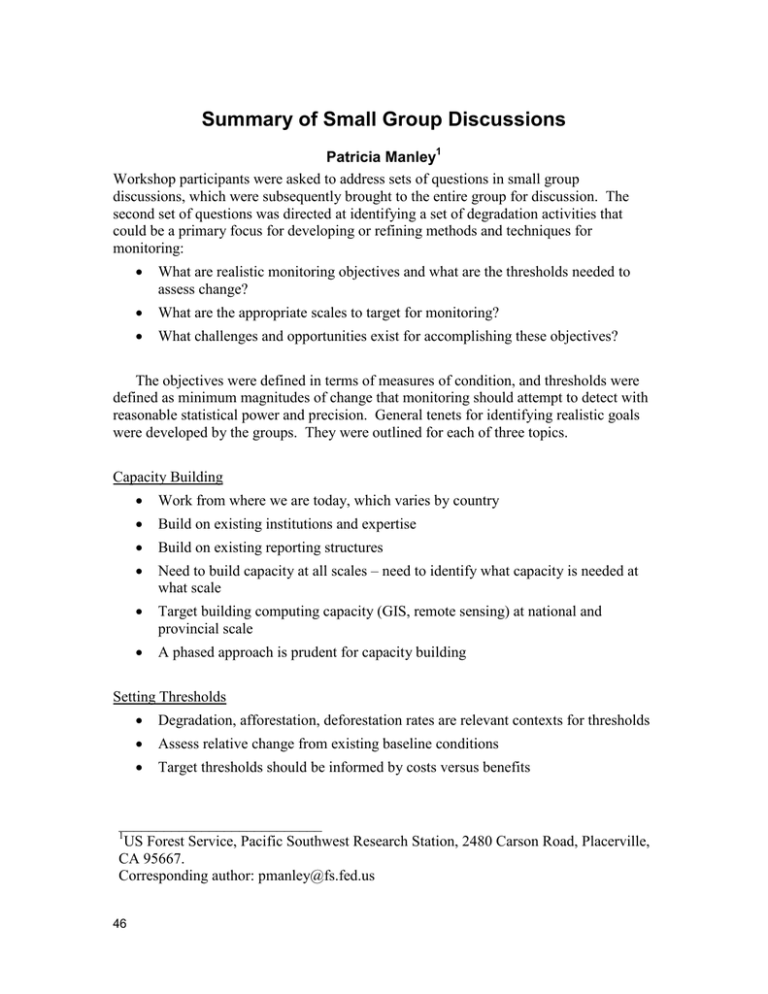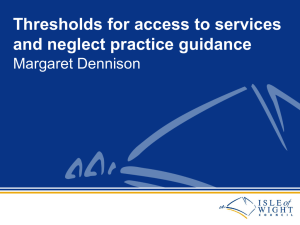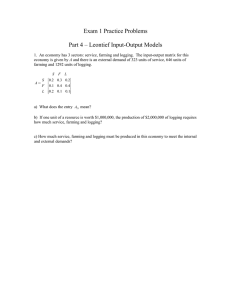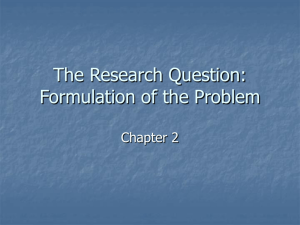Summary of Small Group Discussions
advertisement

Summary of Small Group Discussions Patricia Manley1 Workshop participants were asked to address sets of questions in small group discussions, which were subsequently brought to the entire group for discussion. The second set of questions was directed at identifying a set of degradation activities that could be a primary focus for developing or refining methods and techniques for monitoring: • What are realistic monitoring objectives and what are the thresholds needed to assess change? • What are the appropriate scales to target for monitoring? • What challenges and opportunities exist for accomplishing these objectives? The objectives were defined in terms of measures of condition, and thresholds were defined as minimum magnitudes of change that monitoring should attempt to detect with reasonable statistical power and precision. General tenets for identifying realistic goals were developed by the groups. They were outlined for each of three topics. Capacity Building • Work from where we are today, which varies by country • Build on existing institutions and expertise • Build on existing reporting structures • Need to build capacity at all scales – need to identify what capacity is needed at what scale • Target building computing capacity (GIS, remote sensing) at national and provincial scale • A phased approach is prudent for capacity building Setting Thresholds • Degradation, afforestation, deforestation rates are relevant contexts for thresholds • Assess relative change from existing baseline conditions • Target thresholds should be informed by costs versus benefits ___________________________ 1 US Forest Service, Pacific Southwest Research Station, 2480 Carson Road, Placerville, CA 95667. Corresponding author: pmanley@fs.fed.us 46 • Test and refine target thresholds over time (e.g., through data analysis and modeling) • Reporting frequency should be clearly identified – no more than 5 year intervals • Shifting cultivation can have significant temporary effects on some measure that could mask smaller more permanent effects Implementation • A phased approach is prudent for implementation Use a “no regrets” approach to guide investments in implementation, meaning they will be useful no matter what else gets accomplished Specific objectives and thresholds identified by the discussion groups varied by the type of degradation activity. Targeted activities were those most readily monitored through readily available remote sensing or field data collection methods, and included: selective logging, fuel wood, and swiddening. Fire was identified as another activity for which thresholds could be identified, but the group did not have the opportunity to address fire in any detail. Selective logging was defined here as activities that resulted in wood products (e.g., lumber, poles for houses). Planned commercial logging typically targets larger trees with diameters > 50 cm. Thresholds for this activity minimally would detect reductions of trees >50 cm in diameter and reductions of >50% of the biomass per hectare. Frequency of resample was identified as a maximum of 30 years, assuming that reentry for commercial logging would not be more frequent than that. However, frequency of resample most likely would be a function of reentry rates and required reporting frequencies specific to the area. Unplanned logging represents forest uses for domestic or commercial uses. Unplanned logging can occur in areas that are also subject to planned commercial logging. Tree removal for customary uses typically targets smaller trees with < 50 cm diameters, limited primarily by equipment (e.g., machete, buffalo). Target thresholds for areas subject to unplanned selective logging would be loss of trees >30 cm in diameter and reductions of >30% of the biomass per hectare. Frequency of resample could be any feasible time period, given that tree removal in most areas is occurring throughout the year and every year. Of course, over time accessibility and need will vary, so some areas that were not subject to unplanned logging could begin to be logged. Given the dynamic nature of tree extraction activities, we recommend a minimum 5-year resample or a resample frequency coincident with other forest monitoring measurements for reporting purposes (whichever is shorter) to provide a comprehensive snapshot of conditions across contiguous landscape. Fuel wood removal commonly would occur in the same areas as unplanned logging, given that both are a function of access and need, and the same conditions are favorable to both activities. Therefore, we recommend that the thresholds set for unplanned logging be applied to any forested area with a reasonable risk of degradation by unplanned activities. Degradation risk can be determined by assessing the factors that • 47 directly and indirectly drive unplanned logging and intensive fuel wood collection, such as access, local population size, local poverty levels, etc. (see Chapter 1). Swiddening (i.e., slash and burn shifting agriculture) involves a temporary deforested condition over variable sized areas for a variable number of years. Once the agricultural activity is stopped, the assumption is that the area will recover at the same pace as one would expect after a natural disturbance. The ability to detect swiddening will depend on the size of the clearing, the duration of use, and the density of areas cleared for swiddening at any point in time. Generally, medium resolution Landsat data can detect >1-hectare areas that are maintained for at least 3 years (providing a 4-5 year window of detection). The use of chronosequencing models can help to estimate change in biomass over short periods of time, when combined with accurate land use/land cover change maps. High resolution remote sensing data can enhance these estimates by detecting smaller clearings and refining models. Landscape attributes and village locations can be used to identify areas of high risk of degradation from swiddening, which in turn may influence the frequency and intensity of repeated measures. The challenges and opportunities for identifying monitoring objectives, and thresholds in particular, are many. The primary challenge and the most limiting factor is capacity. The group noted that starting with existing conditions, both ecologically and institutionally, is fundamental to making progress. In most countries, this means starting at basic levels of acquisition of equipment, data, and training. Investments in national and provincial monitoring data and data management/interpretation abilities are essential. The limitation of national and provincial-level investments is that they do not build capacity at the ground level, and as a result the benefits are mostly at those larger scales. Demonstration projects provide a complementary investment to larger-scale investments in that they take place in and involve local communities and staff. Local involvement is one important criterion to successfully determining forest conditions at a level of resolution and reliability that can be used for REDD+ monitoring, and that can help identify problems in a timely manner such that policies and other tools can be put in place to achieve the desired objectives of maintaining or increasing forest cover and forest quality. 48



